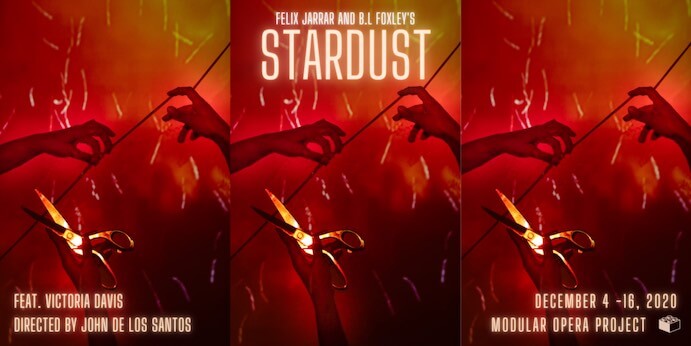As the performing arts continue to suffer from the ongoing repercussions of COVID-19, presenting organizations such as Helios Opera fight the loss of traditional performances with innovative online presentations. One such initiative from Helios Opera is called Modular Opera Project (MOP), a program that offers singers the chance to produce one-act operas from home.
MOP’s latest new work is Stardust, a song cycle with music by Felix Jarrar and libretto by B.L. Foxley. The digital premiere aired on December 4, 2020, with subsequent ticketed streams taking place on December 6, 11, and 13. Stardust clocks in at just under fifteen minutes, which makes its $20 price tag a tough sell, but each of the four digital streams is followed by a post-show talk with special guests, including Melinda Lopez, Chay Jones, Jasmine Rice LaBeija, and Malcolm Hansen.

Victoria Davis in Stardust–Photo courtesy Helios Opera
The libretto to Stardust comes from the eponymous collection of poetry by Foxley, which she considers her tribute to the fantasy genre. Foxley wanted to “depict the realities of 2020 for a person of color finding solace in their craft, questioning their artistic worth before finally escaping into a world of fantasy, embodying utopia.” These poems explore rather abstract and mythic beings and ideas, yet still hold space for intimate and personal experience.
To create his song cycle, Jarrar chose three poems from Foxley’s collection—“WHAT AM I?,” “The Devil,” and “Mother Nature”—for their synergy, imagery, and musical potential. Unlike opera, which generally relies upon a linear narrative, song cycles can explore ideas more abstractly. Stardust considers a loose narrative about race, reckoning, and ultimately, rebirth.
Director John De Los Santos took inspiration from the three Greek Moirai, or Fates, in his vision for Stardust. In the post-show talkback, he explained that the three sisters each have a different task. One sister begins by spinning the thread of life; every time a new human is born, their life is a thread. The second sister pulls the thread out based on how long they will live. And once their time is up, the third sister cuts it. Stardust is filled with a rich palette of images that evoke the Moirai, including a large pair of silver scissors and a ball of twine, among others.

Helios Opera Presents Stardust–Photo by Keith Browning
Stardust is performed by soprano Victoria Davis, who is accompanied by Jarrar on piano. Davis and Jarrar are friends and seasoned collaborators; Davis was featured in Jarrar’s drag comic opera Mother Goose, which premiered at New York’s Dixon Place in 2019. Jarrar’s writing echoes the tumultuous romanticism of well-known Schubert lieder, but with frequent forays into crunchier harmonic palettes. Davis’ warm tone breathed life into the divergent characters of each song and filled the space over Jarrar’s rather punchy yet virtuosic performance on the piano.
The most striking aspect of Stardust was its filmography and visual language. De Los Santos took inspiration from the films of John Waters and Andy Warhol, which use a similar triptych composition where three simultaneous shots are shown side by side on the screen. In the cycle’s second movement, “The Devil,” multiple angles of Davis are juxtaposed to evoke her struggle with the evil being, which perhaps was her all along. A red, circular light box, created by architect and lighting designer Fabian Hernandez, is covered with branches to evoke a mysterious and foreboding atmosphere.
In many ways, De Los Santos’ visuals for Stardust draw parallels to the lived experiences of artists during the pandemic. The circular light box immediately brings to mind the ubiquitous “ring lights” used for at-home lighting for livestreams, Zoom calls, and recording sessions, and the triptych composition echoes the all-too-familiar visual aesthetic of online meetings and displaced social events.

Helios Opera Presents Stardust–Photo by Keith Browning
Assistant Director Keith Browning, more commonly known for his work as an opera singer, took the pandemic lockdown as an opportunity to, in the words of his late father, “just have fun” and experiment with new ways to create. Despite the considerably large production team and organizational support, everything was done on a shoestring budget. The cinematography was done with two iPhones, two IKEA lights, and a backdrop. The sublime thread of the Fates is merely a $2 ball of yarn from Michaels.
At the end of Stardust, Davis shines brighter and brighter until she errupts into a blinding starburst. But this is not her end. The final line of the libretto reads, “Her rebirth in magical blood landed her on earth like a myth.” Similar to the unending work of the Fates, as one thread is severed another is pulled out and measured again. At the heart of Stardust is a powerful message: every ending is a new beginning, and every new beginning is an act of resilience in the shadow of oppression.
I CARE IF YOU LISTEN is a program of the American Composers Forum, funded with generous donor and institutional support. A gift to ACF helps support the work of ICIYL. Editorial decisions are made at the sole discretion of the editor-in-chief. For more on ACF, visit the “At ACF” section or composersforum.org.




















